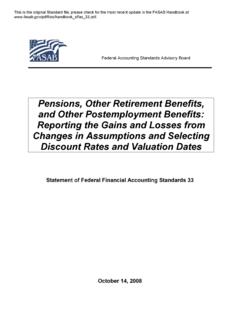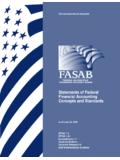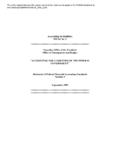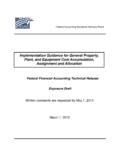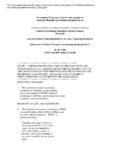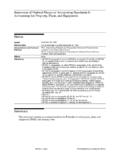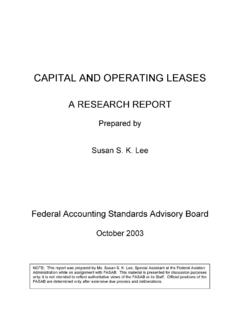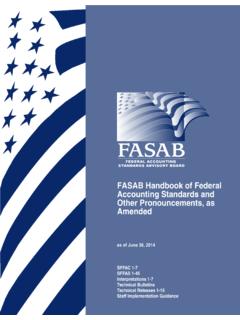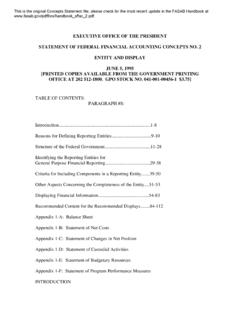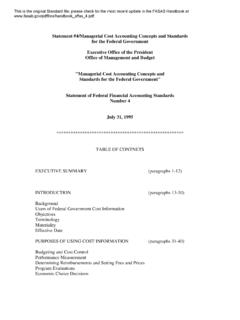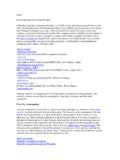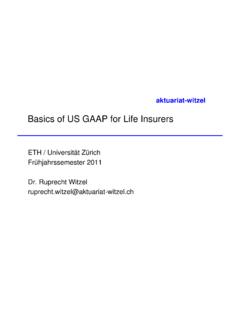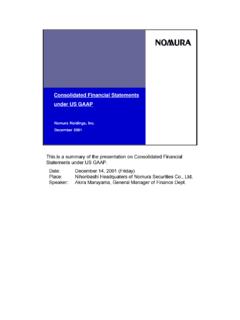Transcription of FASAB
1 ----------------- FASAB -----------------F ederal Accounting Standards Advisory Board Accounting forInternal Use Software Statement of Federal Financial Accounting StandardsNumber 10 June 1998 This is the original Standard file; please check for the most recent update in the FASAB Handbook at is the original Standard file; please check for the most recent update in the FASAB Handbook at FEDERAL ACCOUNTING STANDARDS ADVISORY BOARD The Federal Accounting Standards Advisory Board ( FASAB , or "the Board") was established inOctober 1990 by the Secretary of the Treasury, the Director of the Office of Management and Budget(OMB), and the Comptroller General.
2 The nine-member Board was created to consider and recommendaccounting principles for the federal government. The Board communicates its recommendations by publishing recommended accounting standardsafter considering the financial and budgetary information needs of congressional oversight groups,executive agencies, and other users of federal financial information. The Board also considerscomments from the public on its proposed recommendations, which are published for comments as"exposure drafts." After considering oral and written comments, the standards may be recommendedby the Board.
3 The Board's sponsors then decide whether to adopt the recommendations. If adopted,the standards are published by OMB and the General Accounting Office and become authoritative. The following documents related to the establishment and mission of the Board are available from theFASAB: "Memorandum of Understanding Between the General Accounting Office, theDepartment of the Treasury, and the Office of Management and Budget, on Federal GovernmentAccounting Standards and a Federal Accounting Standards Advisory Board" "Mission Statement: Federal Accounting Standards Advisory Board"This is the original Standard file.
4 Please check for the most recent update in the FASAB Handbook at of Contents_____Executive 2 Effective 2 Accounting 3 Software Development Phases .. 4 Recognition, Measurement, and 7 Software Used as General PP& 7 Capitalizable 7 Data Conversion 8 Cutoff for 8 Multiuse 8 Integrated 9 Bundled Products and 9 Capitalization 13 APPENDIX A: Basis for 14 APPENDIX B: 29 This is the original Standard file; please check for the most recent update in the FASAB Handbook at Summary_____Federal Accounting Standards Advisory BoardAccounting for Internal Use SoftwareJune 1998 Executive SummaryThis statement provides recommended accounting standards for internal use software.
5 Under the provisions of this statement, internal use software is classified as "general property,plant, and equipment" (PP&E) as defined in Statement of Federal Financial Accounting Standards(SFFAS) No. 6, Accounting for Property, Plant, and Equipment. This statement includessoftware used to operate a federal entity's programs ( , financial and administrative software,including that used for project management) and software used to produce the entity's goods andservices ( , air traffic control and loan servicing).Internal use software can be purchased off-the-shelf from commercial vendors and can bedeveloped by contractors with little technical supervision by the federal entity or developedinternally by the federal entity.
6 SFFAS No. 6 specified treatment for internally developedsoftware different from that for commercial off-the-shelf (COTS) software and contractor-developed software. SFFAS No. 6 addressed COTS and contractor-developed softwaregenerally, providing that they were "subject to its provisions." On the other hand, specificprovision was made for internally developed No. 6 prohibited the capitalization of the cost of internally developed softwareunless management intended to recover the cost through user charges, and the software was to beused as general PP&E.
7 For capitalizable software, capitalization would begin after the entitycompleted all planning, designing, coding, and testing activities that are necessary to establish thatthe software can meet the design the conclusion of the PP&E project the Federal Accounting Standards Advisory Boarddiscussed whether the standard for internally developed software should also apply to contractor-developed software. Also, some users of SFFAS No. 6 were unsure how to apply it to COTS andcontractor-developed software. The Board decided, in December 1996, to review the issue anddevelop a separate standard for internal use standard requires the capitalization of the cost of internal use software whether it isCOTS, contractor-developed, or internally developed.
8 Such software serves the same purposesas other general PP&E and functions as a long-lived operating asset. This standard providesguidance regarding the types of cost elements to capitalize, the timing and thresholds ofcapitalization, amortization periods, accounting for impairment, and other is the original Standard file; please check for the most recent update in the FASAB Handbook at is the original Standard file; please check for the most recent update in the FASAB Handbook at Accounting Standards Advisory BoardAccounting for Internal Use SoftwareJune statement provides accounting standards for internal usesoftware1 used by federal entities.
9 Federalentities purchase commercial "off-the-shelf"(COTS) software, hire contractors to developsubstantially all of the desired software(contractor-developed), or develop softwareinternally using their own employees, with orwithout a contractor's assistance (internallydeveloped). statement establishes accounting standards for the cost ofsoftware developed or obtained for internal use. These include the cost of software used to operate an entity's programs ( , financial andadministrative software, including that used for projectmanagement), software used to produce the entity's goods and to provide services( , air traffic control and loan servicing), and software that is developed or obtained for internal use andsubsequently provided to other federal entities with or This statement provides standards on accounting for software consisting ofone or more components or modules.
10 For example, an entity may developan accounting software system containing three elements: a general ledger,an accounts payable subledger, and an accounts receivable subledger. Eachelement might be viewed as a component or module of the entireaccounting software system. This standard may be applied to the total costof the software or, when appropriate, to individual components ormodules. For example, one software module may be implemented beforeothers, in which case, the provisions of this standard for capitalization,amortization, etc.
